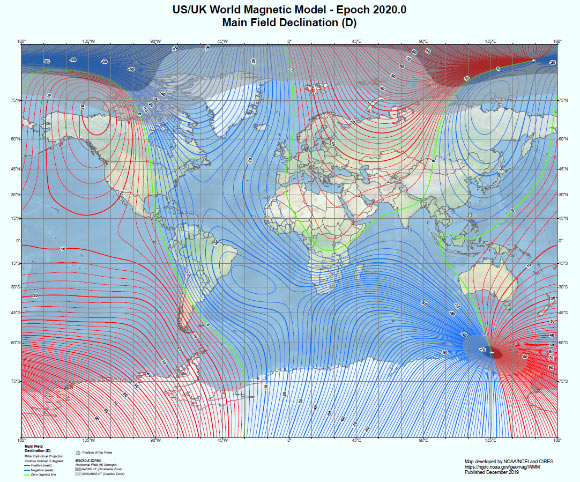Researchers from NOAA’s National Centers for Environmental Information and the British Geological Survey earlier this month released a new version of the World Magnetic Model, a data-based, mathematical representation of Earth’s large-scale magnetic field used for navigation, orientation, and heading references.

The World Magnetic Model 2020. Image credit: NOAA’s National Centers for Environmental Information / British Geological Survey.
Earth’s magnetic field is created by the planet’s moving, molten iron core.
It is constantly changing, and while large-scale changes, such as a complete reversal, happen over several thousand years, smaller changes over shorter periods affect navigation.
Earth’s north magnetic pole was discovered by Sir James Clark Ross in northern Canada in 1831.
Since its discovery, the pole has been moving across the Canadian Arctic towards Siberia.
As its movement is rapid and unpredictable, scientists from the British Geological Survey and NOAA’s National Centers for Environmental Information update the World Magnetic Model (WMM) every five years.
The WMM 2020 version predicts that the northern magnetic pole will continue drifting toward Siberia, although at a slowly decreasing speed — down to about 40 km (25 miles) per year compared to the average speed of 55 km (34 miles) over the past 20 years.
“It’s the fastest recorded shift seen since the mid 16th-century,” said Dr. Ciaran Beggan, a geophysicist at the British Geological Survey.
“Magnetic records show the north magnetic pole has been meandering about Canada from 1590 until 1990 when it suddenly accelerated gain speed over the past 30 years, going from less than 10 km (6.2 miles) per year to almost 60 km (37 miles) per year.”
“However, on the other side of the planet, the south magnetic pole has moved very slowly, drifting around the coast of Antarctica in the same period.”
Geoscientists are yet to understand what has caused an unprecedented gear shift over the past 20 years.
“We know there are irregular changes in the planet’s liquid outer core and that the magnetic field is also weakening under Canada, but it’s not yet possible to say exactly for sure why magnetic north is changing so fast,” Dr. Beggan said.
“The good news is that at Christmas this year, the magnetic pole makes its closest approach to the geographical Pole, so if Santa uses his compass he’ll be pretty much home safe!”







